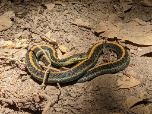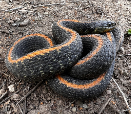Santa Cruz Aquatic Garter Snake (Thamnophis atratus atratus)
Description: Adults are 18 - 40 inches long. Most snakes encountered are generally 18 - 28 inches long. Neonates are 7 - 10 inches. A medium-sized slender snake with a head barely wider than the neck and keeled dorsal scales. Some average scale counts: Average of 8 upper labial scales, 6 and 7 not enlarged. 11 lower labial scales. Rear pair of chin shields is longer than the front. The internasals are longer than they are wide and pointed in front. Average of 19 or 21 scales at mid-body.
Ground color is gray, brown or black. There is a wide yellowish to orange-yellow dorsal stripe, but with the side stripes absent or obscured. There may be small alternating dark spots on the sides. The throat is white or yellow, sometimes bright yellow. The underside is bluish or greenish sometimes with pink or yellow marks.
Habitat: Creeks, streams, small lakes and ponds, in woodland, brush and forest and grassy ecotones. Seems to prefer shallow rocky creeks and streams. When found in muddy ponds there are usually rocky outcrops nearby.
Range: This subspecies is endemic to California. Thamnophis atratus atratus occurs in the "Santa Cruz Mountains and the southern San Francisco Peninsula, from the San Andreas rift lakes to the San Lorenzo River watershed and Uvas Canyon.
Found in these States:
CA
Diet: Probably eats mainly amphibians and their larvae, including frogs, tadpoles, and aquatic salamander larvae (newts and giant salamanders, Taricha and Dicamptodon ), but small fish are also eaten. Captives have also taken small rodents. Leeches may also be consumed. Adults tend to forage actively. Neonates are sit-and-wait foragers. Juveniles practice both types of foraging.
Reproduction: Courtship has been observed during March and April. Females are ovoviviparous - they carry the eggs internally until the young are born live from summer to early fall.
Status: Listed as Least Concern in view of its wide distribution, presumed large population, and because it is unlikely to be declining fast enough to qualify for listing in a more threatened category.
»» Kingdom: Animalia - Animals
»» Phylum: Chordata - Chordates
»» Subphylum: Vertebrata - Vertebrates
»» Class: Reptilia - Reptiles
»» Order: Squamata - Scaled Reptiles
»» Suborder: Serpentes
»» Superfamily: Colubroidea
»» Family: Colubridae - Colubrids
»» Genus: Thamnophis
»» Species: Thamnophis atratus - Aquatic Garter Snakes
»» Subspecies: T. a. atratus - Santa Cruz Aquatic Garter Snake
This article uses material from the Wikipedia article "Aquatic Garter Snake", which is released under the Creative Commons Attribution-Share-Alike License 3.0. Content may have been omitted from the original, but no content has been changed or extended.
|







